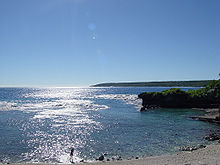Geography of Niue
This article needs additional citations for verification. (April 2019) |

Niue is a small, oval island in the South Pacific Ocean, to the east of Tonga. It has an area of 260 square kilometres, and a coastline of 64 km. It claims an exclusive economic zone of 200 nm, and a territorial sea of 12 nm. It is one of world's largest coral islands.
Climate[]
Niue's climate is tropical, modified by south-east trade winds. Cyclones pose a natural hazard.
Terrain[]

The terrain consists of steep coastal cliffs made from limestone and a central plateau. The lowest point is at sea level, and the highest is an unnamed point near Mutalau settlement, at 68 m.
Natural resources[]
The island's natural resources are fish and arable land. Land use in 1993 was as in the following table:
| Use | Percentage of area |
|---|---|
| arable land | 19 |
| permanent crops | 8 |
| permanent pastures | 4 |
| forests and woodland | 19 |
| other | 50 |
Environmental issues[]
A current environmental issue is increasing attention to conservationist practices to counter loss of soil fertility from traditional slash-and-burn agriculture. Niue is a party to the following international agreements regarding the environment: Biodiversity, Climate Change-Kyoto Protocol, Desertification. Niue has signed but not ratified the Law of the Sea agreement.
Boundaries[]
Niue has signed a treaty with the United States in which the parties delimited the east–west maritime boundary between Niue and American Samoa. Niue is south of American Samoa.
Extreme points[]
This is a list of the extreme points of Niue, the points that are farther north, south, east or west than any other location.
- Northernmost point – unnamed headland north-west of
- Easternmost point – unnamed headland south-east of Liku
- Southernmost point –
- Westernmost point - Halagigie Point
References[]
Coordinates: 19°02′S 169°52′W / 19.033°S 169.867°W![]() This article incorporates public domain material from the CIA World Factbook website https://www.cia.gov/the-world-factbook/.
This article incorporates public domain material from the CIA World Factbook website https://www.cia.gov/the-world-factbook/.
- Geography of Niue
- Niue stubs
- Oceania geography stubs
